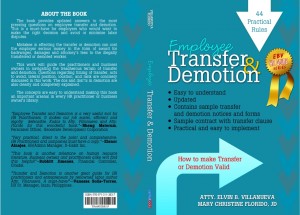The decision to transfer an employee may be a double-edged sword with both favorable and unfavorable consequences. It may be a tool for positive changes or a weapon of destruction.
Companies may use it to promote business growth by sending key and competent personnel to areas where the employer needs them. Conversely, a transfer to a different (usually, distant) location, may be used by some to destroy the life of an unwanted employee as it may cause an unwilling employee to resign or worse, disrupt family life. Regardless of the motives of management, there are repercussions to consider in the transfer of an employee.
Most often, the decision to transfer an employee attracts unwanted labor suit. Once a labor case clamps down on the company, there will certainly be costs involved. Litigation is a hassle that must be avoided because it ordinarily drains the company’s energy, resources and even affects employee morale.
Whether or not the transfer is intended for purely business purposes or to express animosity, the legality of a company’s action will always be determined by the pieces of evidence brought before the labor court. With the wrong evidence, it is possible for a transfer based on good faith to be declared as illegal for violating an employee’s right to security of tenure.
The decision to transfer an employee can be tricky for an employer. Thus, management must take extra caution and observe utmost good faith in doing so. HR practitioners that implement this decision are encouraged to acquire technical competence to carry out this sensitive task.
The question often asked is:
“Is it legal to transfer and demote an employee in the Philippines?”
Employers generally have management prerogatives which include the right to transfer and demote employees but these prerogatives are subject to certain limitations found in legal provisions and case law. These sources of law bind everyone in the Philippines, whether you know of them or not.
IGNORANCE OF THE LAW EXCUSES NO ONE
HR officers and business owners ordinarily implement decisions and later turn to lawyers for advice or worse, legal assistance, only when faced with court action. But an increasing number are now turning to law guides and lawyers for PRIOR advice to avoid serious consequences.
44 Rules on Employee Transfer and Demotion is one such guide which provides answers to the usual questions on employee transfer and demotion. This is a must-have for employers who wish to make the right decision and avoid or minimize litigation.
Mistakes in effecting the transfer or demotion can cost the employer huge sums of money in the form of an award for backwages, damages and attorney’s fees in favor of the illegally transferred or demoted worker.</p>
KNOWLEDGE OF THE RULES WILL KEEP YOU FROM MAKING COSTLY MISTAKES!
This work can guide HR specialists, managers and business owners in making the right decisions and implementing management choices the legal way. Questions regarding timing of transfer, acts to avoid, lateral functions, location, and rank are concisely discussed in this work. The dos and don’ts in demotion are also clearly and completely explained. The concepts are easy to understand making this book an important tool in every HR practitioner or business owner’s business kit.
Read what HR managers and other responsible company officers are saying about this guide:
“Employee Transfer and Demotion is a very useful tool for HR practitioners. It makes our job easier, efficient and legally defensible. Kudos to Atty. Villanueva and Atty. Florido for this wonderful book.” — Bheng Materum, Personnel Officer, Geoestate Corporation
“Very practical, direct to the point and comprehensive.” — Elenor Alnajes. HR/Admin Manager, X-Habit, Inc.
“This book is another milestone in Human Resource literature. Business owners and practitioners alike will find this helpful.” — Bobbit Jimenez, Controller, Citadel
ADDED BONUS!
SAMPLE FORMS INSIDE BOOK
Demotions are treated as dismissals from employment. This is why the latest Supreme Court cases require employers to observe due process including the giving out of notices. Certain things must appear in the notice for it to be sufficient. This book will guide you by providing sample forms relating to demotions and transfers. Just fill them up or make some adjustments to suit the circumstances of your business or employee.
44 rules on Employee Transfer and Demotion is now available at your favorite bookstores (National Bookstore, Fully Booked and Powerbooks) . It is also available in EBook (pdf format), perfect for your PC, Ipad, Kindle and tablet.
